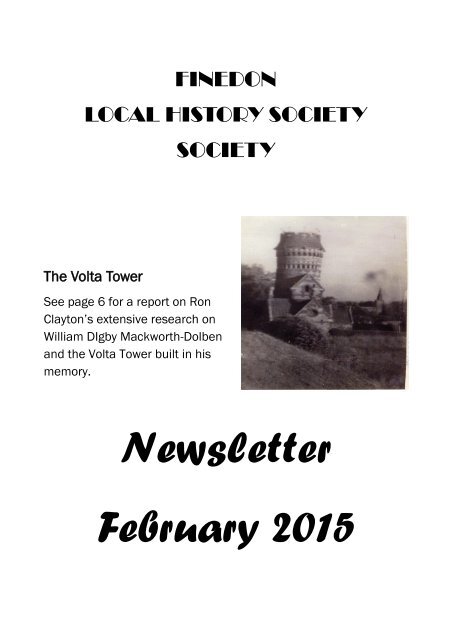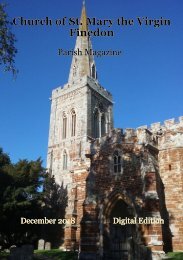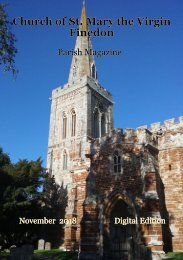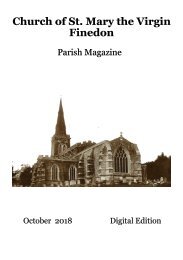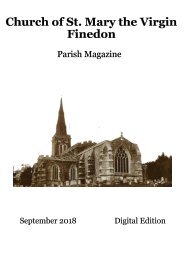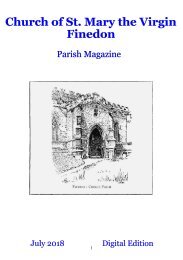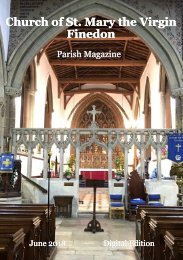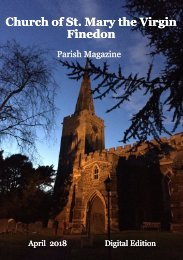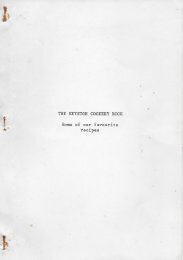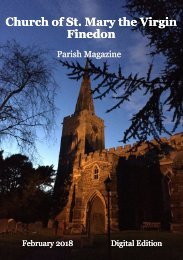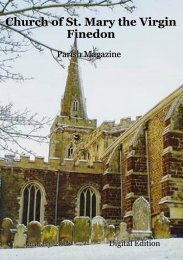Spring 2015 Newsletter
Finedon Local History Society Bi Annual Newsletter
Finedon Local History Society Bi Annual Newsletter
You also want an ePaper? Increase the reach of your titles
YUMPU automatically turns print PDFs into web optimized ePapers that Google loves.
FINEDON<br />
LOCAL HISTORY SOCIETY<br />
SOCIETY<br />
The Volta Tower<br />
See page 6 for a report on Ron<br />
Clayton’s extensive research on<br />
William DIgby Mackworth-Dolben<br />
and the Volta Tower built in his<br />
memory.<br />
<strong>Newsletter</strong><br />
February <strong>2015</strong>
COMMITTEE FOR <strong>2015</strong><br />
The officers and committee members re-elected at the<br />
Annual General Meeting on 25 November 2014 are:-<br />
President Jacqui Minchinton<br />
Chairman Malcolm Peet<br />
Vice Chairman Michael Shipton<br />
Secretary Michael Britton<br />
Treasurer Rachel Terry<br />
Minute Secretary Brenda Beck<br />
Committee Members<br />
Jeremy Millington David Bailey Pat Curtis<br />
Subscriptions<br />
The annual subscription for <strong>2015</strong> has been retained at £5 and<br />
was due on 1 January <strong>2015</strong>. Members who wish to renew their<br />
member-ship should submit their payment to the treasurer Mrs<br />
Rachel Terry, Mill Cottage, Finedon Road, FINEDON, Northants,<br />
NN9 5NQ or any member of the committee.
CHAIRMAN’S FOREWORD<br />
Our first exhibition of 2014 “A Finedon Timeline“ opened in May. The<br />
number of visitors was slightly disappointing, but all of our visitors<br />
were very complimentary. The exhibition identified many of the important<br />
historical events in Finedon over 1000 years. The exhibition<br />
closed on 20 July, in order that our second exhibi-tion for 2014 “ Finedon<br />
at War”, commemorating the Great War of 1914—1918, could be<br />
opened on Saturday 2 August, the nearest weekend to the date that<br />
war was declared. As well as reviewing the factors leading to war, the<br />
exhibition concentrated on the men who served in the military with<br />
specific emphasis on the 133 who paid the ultimate sacrifice and the<br />
impact on those left behind. The committee are very grateful to and<br />
thank members who loaned photographs, service records, artefacts or<br />
have recorded their memories.<br />
Since August, due to illness, I have not been able to undertake many<br />
duties for the society. A consequence of this is that we did not produce<br />
a newsletter in November, for which I apologise. Hopefully, we<br />
should now be able to return to normal. Our sincere thanks are due to<br />
Michael Shipton, for taking up the reins during this period,. This current<br />
newsletter takes a slightly different form from past issues. Three<br />
relatively long articles have been included reducing the amount of<br />
space for past news items from the press.<br />
As announced previously, Jeremy stepped down as secretary at the<br />
AGM but remains on the committee. Carolyn Smith, has kindly taken<br />
on the role of arranging speakers for our monthly meetings and Mick<br />
Britton has taken on role of secretary.<br />
Our next exhibition entitled “From Slate to Whiteboard” will review the<br />
history of education in Finedon. (See page 16)
PROGRAMME <strong>2015</strong><br />
26th Jan. …..........Finedon Men and Medals ……........David Folwell<br />
23rd Feb ..Wicksteed Park and the Lake Project .Charlotte Widgery<br />
Mar 23rd ……....Northants Women in WW1…...... Andrea Pettingay<br />
27th April ...……..Infant mortality and vaccination for shoemakers in<br />
the Rushden Area 1880-1890 ………………...…....Dr Tricia James<br />
20th May (Wed) ……Visit to John Clare Cottage, Helpston …………..<br />
22nd June... Barnwell Manor, Castle & Gardens ...Nicholas Warliker<br />
27th July ...Mary Queen of Scots, a local aspect ….Malcolm Deacon<br />
24th Aug ….Masquerade - the History of Masks ….Christine Farmer<br />
28th Sept .Wellingborough VAD Hospital 1914-1919 .Jon-Paul Carr<br />
26th Oct .The Industrial Heritage of Peter Perkins Northamptonshire<br />
23rd Nov ………………………………..AGM ………………………….<br />
Dec ……………………..……..Carol Singing …………………………..
FINEDON PEOPLE<br />
Charles ”Daddy” Finding .<br />
Charles had a dental practice<br />
in<br />
Allen Road<br />
Members of the Finedon Co-op Committee c. 1950<br />
L—r: Back, ?, Geoff Ballard, ?, Cyril Pearcey.<br />
Front: ?, Cyril Pearcey. Front: ? , ?, Arthur Hearn,<br />
(Chairman)?, ?.
The Volta Tower. Ron Clayton<br />
Following a period of thorough research Ron Clayton was able to clarify and correct a<br />
number of items of previous information believed to relate to Fine-don’s Volta Tower. It<br />
had been understood that the Volta Tower had been erected in memory of William<br />
Digby Mackworth-Dolben who was drowned off the coast of West Africa on September<br />
1st 1863 when the boat he was in with a Lieutenant M’Kinson and Mr Embank was capsized<br />
by a seal. This story is obtained from a log-book kept by his bat-man Thomas<br />
Baker Henfrey. How-ever, closer examination of the handwriting indicates that the boat<br />
was cap-sized by the seas (probably currents crossing the Bar of Lagos) and that he<br />
was accompanied by Lieutenant Atkinson and Mr Ewbank. At that time William Digby<br />
was Lieutenant Commander of HMS Investigator and was part of the British West Africa<br />
Squadron positioned to prevent the illegal trade in slaves.<br />
The name Volta was understood to come from a ship called the Volta on which William<br />
Digby had served but a search of naval records showed no trace of such a ship. Service<br />
records however revealed that when serving on HMS Bloodhound, Lieutenant<br />
Commander Dolben with Lieutenant Thurston Stringer went up the Volta River on an<br />
exploratory expedition. The river was mapped, taking depth readings at approximately<br />
every mile. It was suggested that this was the first time white men had ventured there,<br />
however it is very likely that the Portuguese had been before. Volta means turn back in<br />
Portuguese. Wil-liam Digby then sent a letter to the Royal Geographic Society on the<br />
expedi-tion but was told it was very scanty and of no great interest. Never-the-less the<br />
report was published and William Digby Mackworth-Dolben was made a Fel-low of the<br />
Royal Geographic Society. He would at this time have been listed together with the<br />
likes of Darwin, Livingstone, Speke and Burton. Interestingly, records show that the<br />
famous explorer Richard Burton sailed from Lagos on HMS Bloodhound when it was<br />
commanded by William Digby in 1862 and 1863.<br />
The Volta Tower itself was designed by Edwin Francis Law of Law & Harris and plans<br />
and drawings indicate this was in 1865, so it is unlikely that it was built in 1863 as previously<br />
thought. The finished building was 50% higher than the original plans (90+ feet<br />
as opposed to the planned 60+feet).This may have been a contributory factor in its<br />
collapse in 1951. Although rumour has it that the building was without mortar, this is<br />
untrue. It was built with mortar but was not pointed up.<br />
No specific reason has been attributed to the cause of the Volta Tower’s col-lapse but<br />
photographs of the time show that excavators in the Buccleuch Quarry came perilously<br />
close to the building. Furthermore, Harry Durden, a Finedon resident, reported at the<br />
inquest that at times blasting occurred twice weekly, although there was no blasting at<br />
the time of the collapse.
A final observation from Ron Clayton was that a popular design of tombstone in Victorian<br />
times was that of a broken column, signifying a life cut short. Some-times such<br />
columns were bound with an evergreen wreath near the top. There is a similarity in<br />
the look of the Volta Tower with that of a Victorian column tomb-stone.<br />
FINEDON WOMENS’ CO-OPERATIVE GUILD<br />
By Francis Terry<br />
The roots of the co-operative movement in Britain date back to the 18th century, and by the mid-<br />
19th century several hundred wholesale and retail co-operative societies, mostly in Lancashire<br />
and Yorkshire, agreed to merge into a national organisation. By the turn of the 19th century, the<br />
Co-operative Wholesale Society (CWS) owned factories producing all manner of foodstuffs and<br />
hardware, as well as providing insurance services, funeral par-lours and travel agencies. In<br />
1883, Alice Acland who contributed the ‘Women’s Corner’ feature in the Co-operative News<br />
began organising a ‘Women’s League for the Spread of Co-operation’ which, in time became the<br />
Women’s Co-operative Guild (WCG) with numer-ous branches all over the country.<br />
The Finedon Local History Society is fortunate to hold many of the surviving records of the Finedon<br />
WCG, including the attendance records, contributions register, minute books and songbooks.<br />
This short article gives a few highlights from the collection. The Finedon Guild may have<br />
have been founded in the early 1890s, but the earliest record we found is October 1921. In an<br />
era before the welfare state had developed, the WCG was a principal source of education and<br />
support for women in what was, at the time, an almost exclu-sively domestic role. It provided not<br />
only a focus for social activities, and occasional out-ings, but also took part in political campaigns<br />
aimed at furthering women's’ health, suf-frage and pacifism.<br />
The tone of the WCG’s activities was strongly working class, and often sympathetic to the Labour<br />
movement. As such, it was not universally popular: my own grandmother was ostracised by<br />
her family, when she began courting a keen supporter of the co-operative movement (whom she<br />
later married). The Finedon Guild (Branch No 1385) in its heyday typically attracted an attendance<br />
of 80 – 100 women to its weekly meetings, held in the Co-op hall. Now the upper show<br />
room of NU LOOK KITCHENS AND BATHROOMS. Meet-ings consisted of brief formal business<br />
and reports, for example from the Sick Visitors who delivered a vital function in an age before<br />
the NHS existed. The main item was usu-ally a talk or simple entertainment, often with an educational<br />
or campaigning purpose.<br />
From the minutes of 6 January 1933, we read that 87 members sat down to a New Year’s Tea<br />
with ‘beautifully decorated tables and a nice spread of enjoyable things’. After tea, cornet solos<br />
were given by Master Stanley, recitations by Master Daniels and Mrs Deacon, community choruses<br />
by a ‘merry band of Guiders accompanied by Mrs Morris’ on the pi-ano. Miss Dorothy Trevor<br />
and Miss Joan Twelvetree delighted all with their beautiful danc-
ing display’, there were party games and the President wished all members a ‘Bright and Happy<br />
New Year’ followed by the singing of ‘Auld Lang Syne’. A profit of £1-2-1d (about £70 at present<br />
day prices) was made on the event.<br />
A darker mood is evident from the minutes of 20 January 1937. On the topic of ‘A state within a<br />
state’ the speaker, Mr Avery, remarked ‘how uncertain everything is at the present time. There<br />
are half a million gas-masks being made every week. War is being prepared for and we do not<br />
want it. The goal we as co-operators want to aim for is peace. We do not want to see humanity<br />
destroyed. Life is a wonderful thing and we want to see prosperity [through] co-operating one<br />
with another’. The minutes add that ‘The speaker was listened to with rapt attention and a keen<br />
discussion followed…….<br />
Another indication of the style of Guild activities around this time is given by the pattern of expenditure.<br />
The accounts for February 1936 show that the boy bringing fish and chips for the<br />
members’ tea received 6d for his errand, while the food itself cost 12/9, or about £38 in today’s<br />
money, for a gathering of perhaps 80 women. A postal order for 2/6 (£7.40) was presented to<br />
the Peace Pledge Union, while masks for ‘comic get-up for the Committee’ (presumably for the<br />
Christmas party) cost tenpence ha’penny (£2.50). Contributions to the Co-operative Society head<br />
office amounted to 100 at 9d.<br />
War-time brought many new challenges to the Finedon Guild, and for a time opinion was divided<br />
as to the merits of the conflict (many women opposed armed conflict on principle). The minutes<br />
of 31 December 1940, now written in pencil, record that the only 34 members were able to attend<br />
the Annual Tea, but a ‘very enjoyable time was made with singing and games, the company<br />
being entertained by Mrs Morris at the piano and three little girl evacuees from London’. Owing<br />
to the black-out, the social finished soon after 5pm; the profit was 3/6d.<br />
Three years later, a slightly more optimistic mood was evident, although meetings were now<br />
monthly rather than weekly and there was a heavier emphasis on fund-raising, especially for the<br />
Lads Comfort Fund. By January 1943, the Finedon Guild was being enjoined to ‘plan for peace’,<br />
and ‘get together a Co-op political party’. It was even hoped to see a woman on the CWS board.<br />
There was a feeling that reform – in society as a whole, and in the Co-operative movement –<br />
were on the horizon. Mrs West of Wellingborough, the speaker at the November 1943 meeting,<br />
argued that ‘women ought to be paid the same rate as the men for work they do’. Later, there<br />
were talks on the development of adult education and the health service, and in March 1944<br />
Mrs Ayling of London ‘gave a very interesting address on the Problems of Today on Housing,<br />
Food and the Sex problem’.<br />
In many respects however, the return to peace-time conditions saw the Guild itself functioning<br />
much as it had always done. Meetings were weekly again, but there were signs of changing<br />
times. In October 1950, when Mrs Walker acted as MC for games, dancing and music at the<br />
social meeting, a ‘radiogramme’ was provided by Mrs Richardson; this lady also had the good<br />
fortune to win a pair of stockings, given as a prize by Mrs Emerson, while the Committee gave a<br />
small sketch. The same Mrs Walker next month gave a talk on ‘My holiday in Texas’, a topic that<br />
would have seemed almost fantastical before the war. As the 1950s drew on, attendance at the<br />
Guild declined – 40 was now a more usual number – and there were disappointments when<br />
speakers could not be found or did not turn up. 9
April 1991, the last date for which records are available, saw the Guild holding fast to its traditions.<br />
By now, attendance was down to little more than a dozen members at the fort-nightly<br />
meetings, but the main activities usually consisted of a talk (often illustrated with slides or photographs),<br />
relationships with the wider Co-op movement, fund-raising for vari-ous causes and of<br />
course refreshments served by the Committee. After this, little is cur-rently known about the<br />
Guild except that it ceased to function in the early 1990s. If any reader can contribute information<br />
about this, or has memories of the Guild, they would be most gratefully received. To<br />
know more about the activities of the Co-op in our area, the excellent history of Irthlingborough<br />
Co-op, entitled ‘Time Runs Out’ and published by St Pe-ter’s Historical Society, can be warmly<br />
recommended.<br />
Finedon Goes To War<br />
A Commemorative Exhibition<br />
“Completing the Circle” by Mick Britton<br />
As a member of staff at Montsaye Academy, Rothwell I have, for the past six<br />
years, visited the Somme battlefields<br />
with groups of students as<br />
part of their History curriculum<br />
studies. The tours, in the area of<br />
Albert, have followed a similar<br />
route each year with the students<br />
visiting Commonwealth War<br />
Grave Cemeter-ies, The Thiepval<br />
Memorial and the battle-field of<br />
Beaumont Hamel which was on<br />
the “front line” on the first day of<br />
Battle of the Somme on the 1st<br />
July 1916 when the British Army<br />
suffered over 60,000 casualties on<br />
that single day alone.
Having been part of the team putting together the “Finedon Goes To War – A<br />
Commemorative Exhibition” I was introduced to Peter Inns, the author of the<br />
book ‘ Those That Didn’t’. Peter researched the biographical details of the 133<br />
men who died during the First World War and are listed on Finedon War<br />
Memorial. Using his book as a reference when preparing a range of items for<br />
the exhibition I realised that a number of men are actually remem-bered in two<br />
places I have visited regularly during the past six years.<br />
Ten men of Finedon are remembered at Poziers Memorial and Cemetery and<br />
thirteen at the Thiepval Memorial. These 23 men have no known grave.<br />
The Thiepval Memorial, the Memorial to the Missing of the Somme, bears the<br />
names of more than 72,000 officers and men who died in the Somme sector<br />
before 20th March 1918 and have no known grave. Over 90% of those commemorated<br />
died during the Battle of the Somme, between July and November<br />
1916.<br />
The Poziers Memorial bears the name of over 14,000 officers and men who<br />
died between 21st March and August 1918. The ten Finedon men honoured at<br />
Poziers were all killed in action during the period March 21st – 27th.<br />
Each year we attend the Somme there is usually a student or two who has an<br />
ancestor who was killed on active service in this area. Having researched the<br />
details in school prior to departure we often visit the grave or memorial where a<br />
short act of remembrance is held and a wreath is laid. This September we had<br />
four students who had long lost relatives honoured on the Thiepval Memorial.<br />
This year I took the opportunity to lay a wreath at the Poziers Memorial on<br />
behalf of the Finedon Local History Society. After giving a short talk to the<br />
students followed by an act of remembrance, the wreath was laid at the panel<br />
honouring the fallen of the Northamptonshire Regiment, which includes five of<br />
the ten Finedon men honoured at this memorial.<br />
Having been involved with the research, planning and presenting the “Finedon<br />
At War – A Commemorative Exhibition” it was indeed an honour to lay a<br />
wreath on behalf of the Society and “complete the circle”.
Finedon 1875<br />
November 2014 — Summary of talk by John Bailey<br />
Although this popular talk was listed as relating to 1875, other periods<br />
were covered by John. There was an interesting film of Bob Donald and<br />
his farm workers harvesting before World War II, using an old reaper<br />
binder and a belt driven elevator stacking the sheaves of straw.<br />
There was also a short film showing the Free French at the hall, including<br />
the visit of General de Gaulle. Part of the film showed a pet monkey<br />
climbing up the face of the hall. Several other photographs of Finedon,<br />
not previously seen were also shown.<br />
The main feature of the talk showed John Hawkes and his family at Carol<br />
<strong>Spring</strong> farm in 1861. Later shots showed the Hawkes family at Elm<br />
Lodge Farm (later the Mulso Arms ) in 1875. Many animals were shown<br />
on the farm at the rear of Elm Lodge. At this time many animals would<br />
have been raised in the numerous farms within Finedon.<br />
Carol <strong>Spring</strong> farm house which is situated on the east side of Sidegate Lane may not<br />
be known by many of the present residents of Finedon. A recent picture of the house is<br />
shown below.
The “Brush Dance” explained<br />
Following the request for information about the “Brush<br />
Dance” Phil Gobbey, our oldest member, called to pro-vide<br />
the following information.<br />
The dance was invented by Jack Martin, landlord of the Bell<br />
Inn, and was often performed at the end of the singsongs frequently<br />
held on Saturday evenings at the Bell. Music was provided<br />
by: four musicians, Jack Martin (trombone), Phil Gobbey<br />
(trumpet), and two oth-ers Phil can still hum the tune<br />
played. The dancer(s) with the brush would take a few steps<br />
forward and brush the floor in front of them. They would then<br />
step over the brush with the right leg followed by the left leg<br />
before returning to the start position. The sequence could be<br />
repeated several times.<br />
FROM THE PHOTO ARCHIVE<br />
Ernest Lowe’s newsagents<br />
shop on High Street — demolished<br />
in the 1960s. Previously<br />
the busi-ness of Mr Hasledine,<br />
immedi-ately prior to demolition,<br />
one of Swann’s shops.<br />
Ernest Lowe had the nickname<br />
“Doc ha’penny” resulting<br />
from the action taken<br />
when one of the de-livery boys<br />
or girls made a mis-take.
Two 1916 postcards from WWI. Before the days of political correctness.
Arthur “Chuckle” York with his Dahlias c.1955. Arthur was a very keen exhibitor<br />
at local flower shows, both in Finedon and the surrounding district.<br />
Catering staff at a Royal British Legion dinner. L to R: Bessie Henderson,<br />
Joyce Howe, Doreen Hearn, Sandra Henderson, Beryl Needle.


